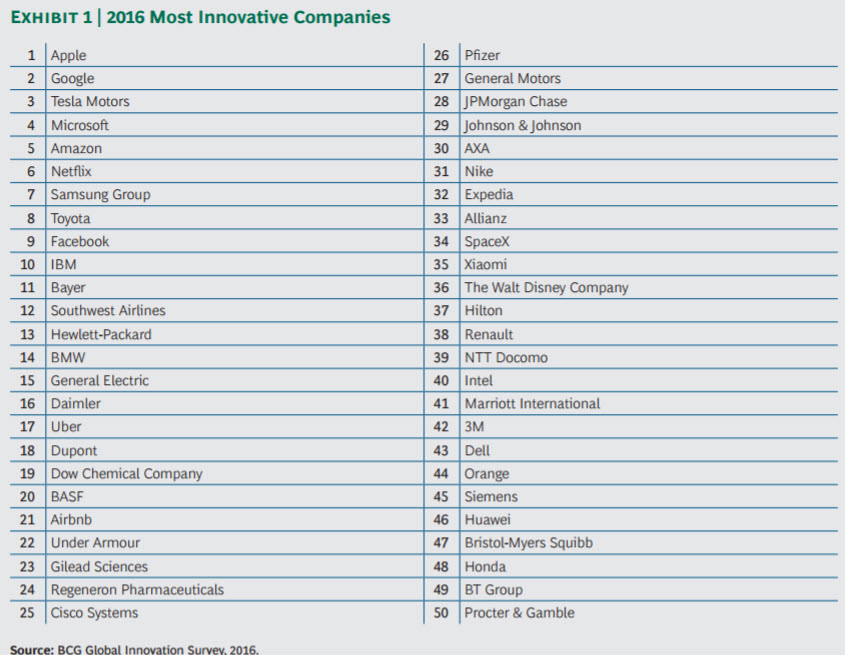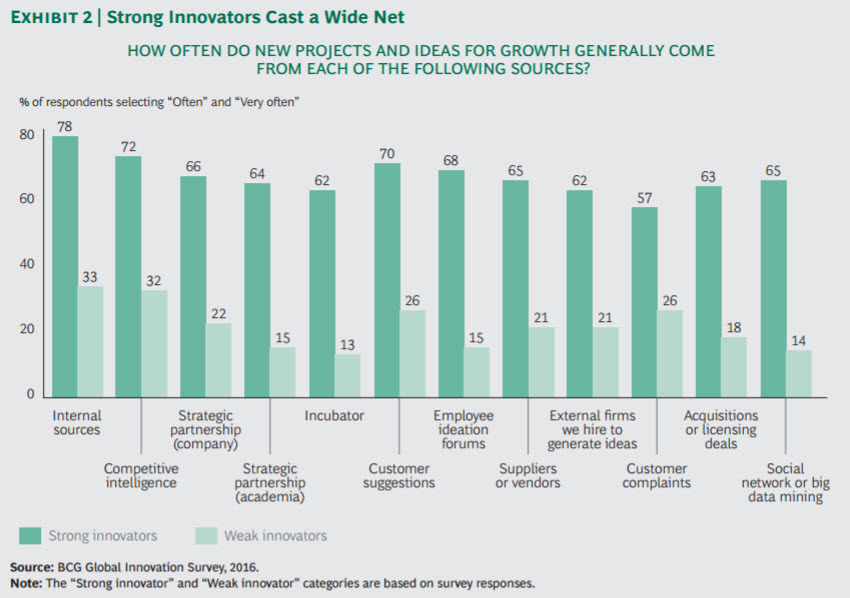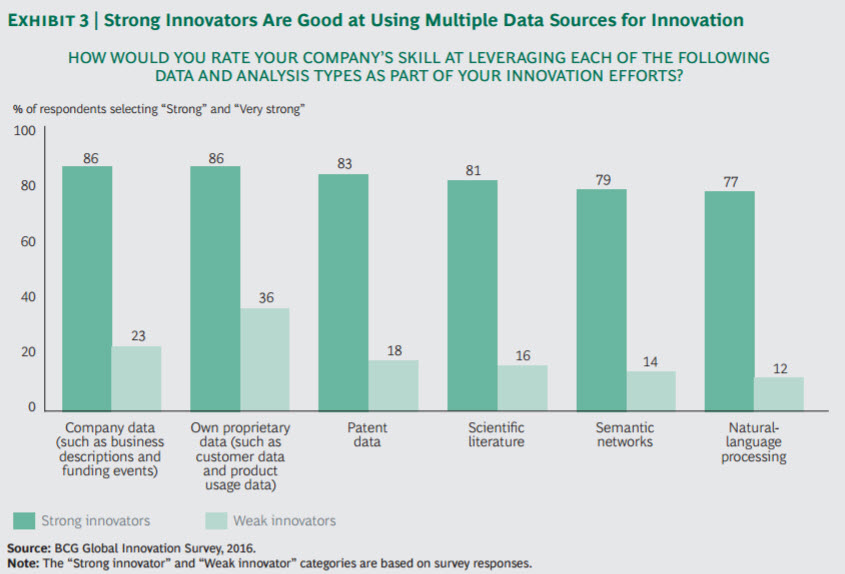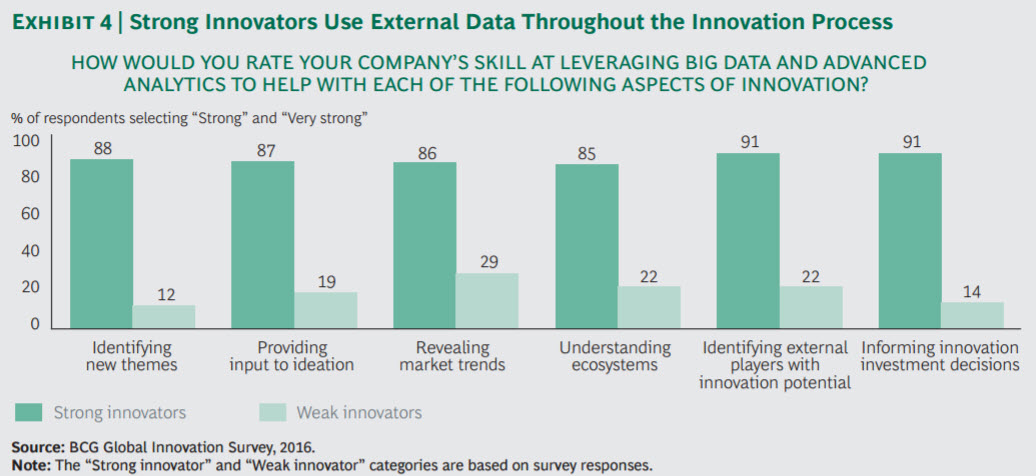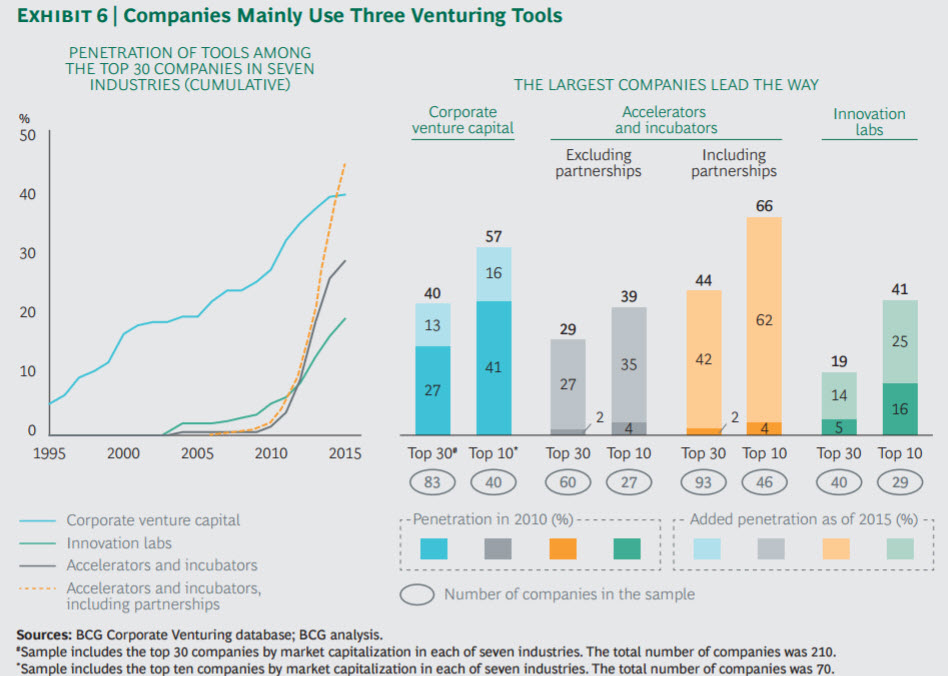BCG recently published its 11th annual global survey of the most innovative companies here (PDF, 1.1Mb). It’s brief (20pg) and not controversial. It highlights a few case studies – J&J, Cisco, BASF and Under Armour. See the list of top 50 companies. Consultantsmind opinions in red.
No surprise you see FAANG companies (Facebook, Apple, Amazon, Netflix, Google). Also, Tesla, Uber, Nike, SpaceX, Intel, Samsung, IBM, Disney are easy choices. Like to see some of the oldie-goldie, MBA case study companies still in the ranks – DuPont, 3M, Southwest, Intel, Dell, HP, Marriott, and Honda. Also, like to see Huawei (Chinese appliance manufacturer) charging their way in. B2B manufacturers also present – Siemens, GE. A little surprised to not see more emerging market growth companies.
This is a surprisingly short report for the importance of the topic. BCG does not provide any analytical framework to think about innovation differently. Instead, they focus more on the HOW of innovation discover and nurturing – incubators, innovation labs etc. . .
Innovators cast a wide net. This seems a bit obvious, but it’s useful to see the many different ways that innovations are identified and bubble up. Some are internal, many are external. Some are proactive (searching patents), some are reactive (customer complaints).
Would have been useful to see how strategists should think of the different means of discovery – pros / cons of each approach, applicability of innovation findings, how to place your bets and manage your innovation investment mix. Seems like there is 15 pages missing in this report – too much summary and survey. Would have liked to see more point of view.
Competitive intelligence is the 2nd most commonly mentioned method for innovation identification. Is “copying” a source of differentiation? Peter Thiel says no.
Paying attention. I like how 5 of the 12 sources are essentially free and widely available to companies if they are alert and responsive (customer suggestions, customer complaints, suppliers/vendors, employee ideation, and social network/big data mining). It just shows that company culture matters; it sets the direction and encourages the right behaviors:
- Customer suggestions and complaints are addressed; feedback is appreciated
- Employee ideas survive the skeptical managerial review, and bubble to the top
- Suppliers are willing to bring forward ideas without fear of reprisal and RFPs
M&A helps drive innovation capture. As I blogged before, 2015 was a peak year for M&A, and 2016 was strong as well. Cisco has acquired 175 companies since 1993, average 8 per year. Facebook bought Instagram and Occulus VR soon after its IPO. GM bought 2 technology start ups in 2016.
- M&A is a core competency for some companies – they are able to astutely identify targets, pay reasonable prices, and integrate / manage them well
- However, for most companies (poor innovators), M&A is the lazy way to bolt-on a new functionality which rarely succeeds; it’s a one-off transaction that destroys shareholder value
Innovator use data effectively. Also seems obvious, but surprising uncommon in the corporate world. Too often they cannot harness the data they already have access to. Too much focus on tactics, inputs, projects, and details. The greater consulting question: What questions are we trying to solve?
Innovators use big data to: 1) identify new themes, 2) provide input to ideation, 3) reveal market trends, 4) understand ecosystems, 5) identify external players with innovation potential, and 6) inform innovation investment decisions.
Admittedly, I am a neophyte in this area, but all of these 5 elements seem to be very exploratory and not very explanatory. Namely, yes, it helps you to be aware of stuff – but does not really help to drive insightful, sustainable recommendations. Lots of brainstorming and “understanding”. . . not helping executives to make difficult decisions.
Innovators use corporate venture capital, accelerators/incubators, and innovation labs. For me the big takeaway is that companies who differentiate themselves through innovation – need to use all the tools they have at their disposal. On the graph on the left, the big increase comes from incubators (including partnership).
Sadly, I have seen large companies struggle managing their own innovation ambitions – too often there will be dozens of uncoordinated research / innovation efforts – struggling to get critical mass, stepping on each other’s toes, and overly matrix-ed with sales business units. Too often, it is unclear on how their work maps into the larger strategy. For me, the formula to success is leadership, direction, and trust.
Strategy. If you look at this list of top innovators, you immediately realize that these companies are doing DIFFERENT THINGS in a coordinated way. They have a direction, sense of self-identity and don’t mind being different. This is not a managerial problem of minimizing risk – NO – This is a leadership challenge to take calculated risks.
Related posts:

